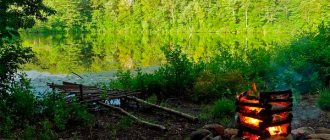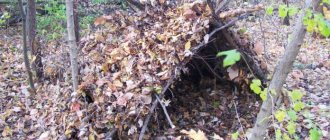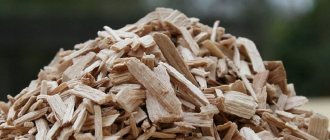What kind of wood is best for a fire?
They say that you can endlessly look at three things: how the fire burns, how the water flows, and the third according to the wishes and tastes of the speaker. And that's true. The flame of a fire can not only warm, illuminate and feed. It may make you think. Some peoples saw secret signs in the flames, others - great omens. For modern people, a fire is associated not with drying clothes and warmth, but with the peace and light of the flame. Unfortunately, modern life has deprived people of the pleasure of relaxing by the fire. In the modern world, you need to get out into nature and only there enjoy the crackling of firewood and wonderful flames.
First of all, the firewood must be dry. This is obvious even to someone who has never lit a fire.
For cooking in a cauldron over a fire, oak and birch are most valued. Firewood from these trees burns, releasing a lot of heat. It is good to use wood chips for ignition; large logs should be thrown into an already lit fire. In addition to oak and birch, you can use any deciduous trees. The most valuable firewood is considered to be that which has been prepared in the winter: beech, hornbeam, oak, acacia, and birch.
To build a fire you will need both large logs and small dry twigs and bark to start a fire. brushwood is also suitable for a small fire. The latter is the best option in the absence of the opportunity to prepare firewood. For example, if there is no tool. It can also be used to kindle larger firewood that will not ignite on its own without reaching the required temperature.
Conifers burn out very quickly, but brightly. It is better not to use fires made from these species to dry clothes - coniferous trees have the ability to throw out sparks, which can damage not only clothes, but also people sitting nearby.
We recommend reading:
DrimSim - tourist SIM card for travelers
A direct indicator of the quality of firewood is the presence of moisture in it. The more moisture the wood contains, the more energy is spent on its evaporation, and not on heating the room, for example. Therefore, using raw firewood is similar to simply throwing it away.
Characteristics of firewood
It is not always appropriate to compare heating a house with a stove and electricity or gas, since the stove additionally creates an atmosphere of comfort and unique family coziness. How pleasant it is to hear the soft crackling of firewood in the hearth in the silence of the doom, to feel the warmth emanating from it. Even in our time, these unique feelings are so pleasant to people that a high-quality stove or a good fireplace is built in almost every private home.
However, in order to effectively use the capabilities of the stove, you should understand firewood. It turns out that not all tree species are equally good for burning; there are many nuances that significantly complicate the choice of firewood for the stove.
For example, for burning in a fireplace, it is advisable to find wood that, when burned, emits a pleasant aroma, but does not emit a large amount of resin, soot, or soot. Resins in wood contribute to increased smoke output, as well as explosive cracking of logs with the release of large coals. Such emissions will be unsafe for an open fireplace, so coniferous wood is not used in them.
Firewood for the stove is selected based on heat transfer; its main criteria are the intensity and duration of combustion. It is desirable that the wood burns with less smoke and leaves behind a minimum of ash.
Wood for making fire
If we consider the optimal firewood for use in a stove, then it should have the following functionality:
- First of all, heat transfer is the maximum possible for wood.
- The flammability of the wood must also be excellent, so that lighting a fireplace is not difficult.
- When burned, firewood should not emit a lot of smoke and leave behind a small amount of ash.
To achieve such characteristics, it is important not only to choose the right type of wood, but also to properly dry the harvested timber and ensure its normal storage. Freshly cut wood is not used in kilns; to prepare it, it should be dried for some time, getting rid of excess moisture. Wet wood burns weakly and produces a large amount of smoke.
There is even a method for determining whether firewood is dry enough for use in fireplaces or stoves. You should hit one log against another and listen to the sound. If it is sonorous, then it is quite possible to use such logs for heating the hearth.
It is believed that the best firewood for fireplaces and stoves is obtained if logging is carried out in the winter. At this time, the trees are in a certain preserved state, as a result of which sap flow practically does not work in them. The worst thing is if the firewood is collected in the spring or summer, when the wood contains a large amount of moisture, such wood will dry out for a very long time.
Firewood harvested in winter can be split in summer
If we consider tree species, then it is best to choose deciduous options, since they have a fairly dense fiber structure. Such wood is capable of generating large amounts of heat for a long time. Most often, firewood is prepared from the following hardwoods: oak, birch, linden, alder, ash, aspen. Even fruit trees can be a good source of heat. In addition, the fragrant wood is perfect for use in a smokehouse or open fireplace.
Good to know: How to make a firewood rack for firewood outdoors and at home with your own hands
Coniferous wood also burns well, but since they contain a large amount of resin, they emit a lot of smoke and soot when burning. The needles burn quite quickly, but produce mediocre heat, so for use in a stove at home it is better not to particularly consider this option, but to save the logs for the bath.
Fire temperature in a wood fire
A good flame requires air; during combustion, a chemical reaction occurs and the organic substances contained in the wood are converted into steam and carbon dioxide, releasing heat.
Firewood prepared from different types of wood burns differently. Some burn quickly and brightly, others leave a lot of ash and burn dullly and for a long time, others burn out for a long time and their coals provide a lot of heat.
Beech and hornbeam firewood produces the highest temperatures – up to a thousand degrees Celsius. The lowest temperature, not reaching even half the heat of the latter, is given by poplar. Alder, aspen, pine, linden, acacia, fir, birch, oak, and larch burn hotter than poplar.
The combustion temperature is affected not only by the type of wood, but also by the availability of oxygen and the design of the stove. For example, in a large stone stove, wood burns quickly, but the stove absorbs their heat and can release it to the environment for a long time. On the contrary, a small stove - a potbelly stove - does not retain heat, immediately releasing it into the room.
Firewood from deciduous trees
In order to optimally choose firewood for heating the stove, based on specific needs, let’s first consider the most popular species of deciduous trees for use in heating the house.
Oak firewood. Experts have long noted oak firewood as wood with almost maximum heat transfer (oak is inferior to ash). At the same time, oak burns for a long time, which allows you to significantly reduce the consumption of logs. These characteristics of oak are explained by its dense, hard structure. Naturally, oak firewood is more expensive than all others, but savings can be seen in the ability to heat a room with less fuel.
Harvesting oak wood
It is believed that middle-aged oak should be used for harvesting, since it is at this time that its characteristics are maximum. When burned, such wood emits intense heat, as well as a very pleasant, characteristic aroma of the forest. Oak firewood is actively used to fire open fireplaces; they allow you to create a pleasant atmosphere in the room, filled with the healing aromas of the forest.
Interesting fact: true Italian pizza is baked in an oven using exclusively oak wood. Italy is not rich in this type of firewood, so oak wood is very valuable in this country.
Ash has similar characteristics, as do fruit trees such as apple or pear, but they must also be harvested at a certain average age.
Birch firewood. The next very popular wood we will look at is birch. Birch firewood is actively used for stoves in bathhouses, as it not only provides excellent heat and aroma, but is also endowed with disinfectant properties. In addition to this, a bathhouse heated with birch wood is full of healing properties; it perfectly helps to cope with colds and chronic respiratory problems.
However, there are also nuances when harvesting birch. It has long been proven that firewood from this tree loses its main properties after 2-3 years of storage. This can be determined by the appearance of the log; it becomes rotten. You should not expect intense heat from such firewood, and the classic aroma completely disappears from them.
Preparation of birch firewood
Birch wood and its bark contain a large amount of tar. You can observe it when the bark burns, when it begins to emit black clouds of smoke. Tar is a carbon compound, so it can ignite instantly and burn with great intensity. Moreover, after combustion there is practically no ash left from the birch. Birch bark and logs are often used to light stoves, since such wood burns even when damp.
Good to know: Fuel briquettes made from sunflower seeds and husks, general overview
If we compare birch firewood and pine or alder wood, then in terms of heat transfer they are 25-30% higher.
Alder firewood. Alder wood can be immediately recognized by its characteristic color, which can be orange, red, bluish, or ocher. Different colors indicate a specific breed of alder, and at the moment there are about 20-25 of them. In ancient times, alder firewood was called “royal” firewood, since it was used for heating the houses of the nobility for many centuries.
Alder firewood has a remarkable property: it dries independently under normal storage conditions. This property is most often characteristic of alder, which grew far from rivers, lakes, and in soil with a small amount of moisture.
Another remarkable property of alder is its unique aroma, which the wood retains for 2-3 years of storage. After this time, the aroma during combustion will be negligible, but the level of heat transfer will not change. In ancient times, alder was actively used to fire black saunas, since when burned it produces virtually no smoke. It is believed that alder wood helps clear soot from the chimney, releasing a certain type of vapor during combustion.
Harvesting firewood from alder
Possessing a unique aroma, alder is actively used in smoking meat and fish; it is not without reason that when harvesting alder, sawdust is collected for future use.
Ash firewood. Ash wood is rarely found on sale and is expensive, since in terms of heat transfer this type of wood is comparable to oak, and even slightly superior. Harvesting ash involves certain problems; due to its hard structure, it is very difficult to saw into pieces.
Note that ash burns well even when damp, it does not spark and produces an even flame. If you need to heat the stove with raw wood, use ash or birch. If you find such firewood at an affordable price, be sure to purchase it.
Scarce ash firewood
Firewood from linden. To quickly light stoves, experienced owners can use linden wood. The wood of this tree is quite difficult to set in fire, but then burns very intensely, releasing a large amount of heat, which contributes to the rapid heating of the stove. This property is perfect for firewood for a bathhouse, the main task of which is to prepare excellent conditions for relaxation in a short time.
In addition, like birch firewood, linden has healing properties; it helps with colds and respiratory diseases. It is believed that if you add a few spoons of honey to the linden firebox, the resulting combined aroma and steam will heal old, poorly healing wounds.
Linden firewood does not lose its properties for about two years after cutting down the tree. In the third year, the healing and thermal characteristics of the wood gradually fade away.
Good to know: What kind of firewood is best to use to light a fireplace?
Firewood from aspen. Aspen firewood is similar in functionality to alder, at least it also effectively fights soot in the chimney. When burned, aspen produces virtually no smoke and produces characteristic steam. This steam has a beneficial effect on soot, which softens and moves away from the walls of the chimney. When aspen wood burns inside the stove, you can hear soot falling into the firebox or ash pan.
Harvesting firewood from aspen
At the same time, the heat transfer from burning aspen is small and is unlikely to be enough to fully heat the room. Therefore, such firewood is used exclusively for preventive purposes. Aspen firewood for the stove will be extremely necessary if it was previously heated with coniferous wood.
Firewood from willow and poplar. Poplar and willow firewood have one drawback. They are rarely used to fire stoves because they burn out very quickly. To heat a room with such firewood, you need to use a lot of it, so even a low, attractive price is not able to concentrate attention on it.
Experts have long classified willow and poplar firewood as low-grade, which is used in rare cases when a normal type of wood is not available.
Firewood from fruit trees. You rarely see firewood from fruit trees, but in terms of their characteristics they are quite good.
Such wood in a stove will easily warm a house, but most often this wood is used for fireplaces or smokehouses due to its exclusivity. It is rare to find such firewood, because most often they appear after cutting down old orchards.
How to make a fire from wet wood
Tourists have this joke: “the best wood for a fire is the one that is available.” And this is fair, because when you are setting up for the night and you need to cook food, dry clothes and just warm up, there is definitely no time to look at the firewood and choose the right types. What if it’s also raining?
We recommend reading:
Sights of Albania
Damp firewood causes difficulties, but nothing is impossible. First of all, it is necessary to divide the firewood into smaller ones - after all, smaller parts dry faster than larger ones. There is a high probability that the inside of the log will be drier than the outside. Therefore, the chips must be separated from the internal part.
More or less dry wood chips should be folded in the form of a hut, it is advisable to place a fire inside. The entire structure can be sprinkled with fine salt, it will help collect excess moisture. And a small fire is lit. If the structure does not ignite, it means the wood chips have not dried enough and the procedure must be repeated. When the wood chips are hot enough, larger firewood can be added to the structure. It is important to monitor the flame and not block access to oxygen.
How to make a fire without wood
There are often situations in which it is not possible to look for a source of firewood. In this case, a Finnish candle can help. To start this type of fire you only need one large log. It needs to be cut from different sides and three-quarters of the height. The ignition is placed in the center and lit. It is very convenient to cook on such a fire; you can take it with you into a log and reuse it.
Author of the publication
offline 3 years
Nika
10
I am interested in hiking and traveling, photography and videography. I have been going hiking since childhood. The whole family went and went - sometimes to the sea, then to the river, to the lake, to the forest. There was a time when we spent a whole month in the forest. We lived in tents and cooked over fires. This is probably why I am still drawn to the forest and, in general, to nature. I travel regularly. About three trips a year for 10-15 days and many 2 and 3 day hikes.
Comments: 0Publications: 668Registration: 10/23/2018
Nika Survival in the wild, Fire, heat, Articles











